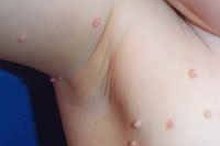Cellulite Above the Knee
Most women suffer the dimpled skin of cellulite at some point in life. Cellulite commonly appears above the knees or on your hips and buttocks and can’t be prevented, although the condition is not a threat to your health. Weight gain, genetics and loss of skin tone can lead to the appearance of cellulite.
Does It Matter?
Cellulite is signaled by the appearance of bumps or dimples above the knees that have a similar texture to cottage cheese. The area around your knees is subject to cellulite due to the natural presence of extra layers of fat, which are also common around your stomach and buttocks. Doctors don’t classify cellulite as a medical condition, although some women with cellulite experience self-esteem issues.
What Causes Dimpled Skin?
Cellulite in Children
Learn More
Your skin connects to the fat layer underneath your skin by collagen fibers. In women, this connective tissue has a honeycomb pattern, whereas in men, the pattern is more crisscrossed. The honeycomb pattern allows fat between the fibers to press against the underside of your skin, which results in the uneven texture of cellulite. Cellulite that appears only when you pinch the skin above your knees represents a less serious case of the condition, while rough, bumpy areas are more severe.
- Your skin connects to the fat layer underneath your skin by collagen fibers.
- The honeycomb pattern allows fat between the fibers to press against the underside of your skin, which results in the uneven texture of cellulite.
Risk Factors
While men suffer cellulite above the knees in rare cases, eight in 10 women experience the skin condition. Your risk rises for cellulite as you age and the elasticity of your skin decreases, although weight gain, stress levels and your family history also contribute to your likelihood for cellulite.
Do Treatments Work?
Will Running Reduce Cellulite?
Learn More
Numerous products claim to cure cellulite, including creams, lotions, detoxification diets and colon cleansers. Evidence is lacking to prove the existence of any cure for cellulite. Liposuction, a common treatment for cellulite, often worsens the appearance of skin, although radiofrequency systems and lasers that combine tissue massage with infrared light or laser energy can temporarily reduce the appearance of cellulite. For positive effects, it is sometimes necessary to undergo treatment for up to six months. The best treatment for cellulite is a healthy lifestyle. The appearance of cellulite can be effectively minimized -- not cured -- through a diet combined with regular exercise.
- Numerous products claim to cure cellulite, including creams, lotions, detoxification diets and colon cleansers.
- Liposuction, a common treatment for cellulite, often worsens the appearance of skin, although radiofrequency systems and lasers that combine tissue massage with infrared light or laser energy can temporarily reduce the appearance of cellulite.
What Is a Healthy Lifestyle?
Regular exercise on most days of the week for at least 30 minutes of moderate-intensity exercise helps stabilize your weight and improves body functions. Weight loss diminishes the appearance of cellulite above your knees as you have less fat to press through your connective tissue. Combine your exercise plan with healthy food choices, such as leafy green vegetables, whole grains, low-fat dairy products and lean meats.
Related Articles
References
- Los Angeles Times: Sorry, No Quick Fix for Cellulite
- MedlinePlus: Cellulite
- New York Times The Truth About Cellulite Treatments
- Scientific American: Is Cellulite Forever?
- Dover, J. S., Orringer, J. S., Alam, M. (2014). Body Shaping, Skin Fat and Cellulite E-Book: Procedures in Cosmetic Dermatology Series. United Kingdom: Elsevier Health Sciences.
- Tokarska K, Tokarski S, Woźniacka A, Sysa-Jędrzejowska A, Bogaczewicz J. Cellulite: a cosmetic or systemic issue? Contemporary views on the etiopathogenesis of cellulite. Postepy Dermatol Alergol. 2018;35(5):442-446. doi:10.5114/ada.2018.77235
- Luebberding S, Krueger N, Sadick NS. Cellulite: An evidence-based review. Am J Clin Dermatol. 2015;16(4):243-256. doi:10.1007/s40257-015-0129-5
- American Academy of Dermatology Association. Cellulite treatments: What really works?.
- U.S. Food & Drug Administration. ZELTIQ CoolSculpting System 510(k). Published September 24, 2015.
- Zerini I, Sisti A, Cuomo R, et al. Cellulite treatment: A comprehensive literature review. J Cosmet Dermatol. 2015;14(3):224-40. doi:10.1111/jocd.12154
Writer Bio
Toby Pendergrass began writing and editing in 1998. He has served as editor for numerous custom health publications and physician journals. His work has appeared in publications such as Hospital Corporation of America's "YOU." He enjoys writing about cardiology and cancer care and holds a Bachelor of Arts in communication from the University of Tennessee at Chattanooga.









